Bitcoin Transaction Fees Surpass Ethereum's Ahead of Halving
Bitcoin Transaction Fees Surpass Ethereum's Ahead of Halving: What Does It Mean for the Cryptocurrency Market?

Bitcoin Transaction Fees Surpass Ethereum's Ahead of Halving: What Does It Mean for the Cryptocurrency Market?
In recent days, Bitcoin transaction fees have exceeded those of Ethereum, sparking discussions about the future of both cryptocurrencies. This dynamic market movement occurs in the context of an upcoming event known as the Bitcoin halving, which has a significant impact on its ecosystem. But what does this increase in transaction fees mean, and what are its implications for investors and miners?
On April 17th, Bitcoin miners collected a substantial sum of $7.47 million from transaction fees, surpassing the $7.31 million received by Ethereum stakers. This significant increase indicates the growing role of transaction fees in the Bitcoin world, especially in the context of the upcoming halving.
Bitcoin Halving: What Is It and How Does It Affect the Ecosystem?
To understand the significance of this event, let's briefly examine what the Bitcoin halving is. Halving is a process in which the reward for miners for mining new blocks is reduced by half. In the case of Bitcoin, this reward currently stands at 6.25 BTC and is set to decrease to 3.125 BTC. This is significant for the entire Bitcoin ecosystem as it affects the supply of new coins and the motivation of miners to maintain the network. With the reduction in the reward, transaction fees become an increasingly important source of income for miners.
Increase in Transaction Fees: Implications and Challenges
This increase in transaction fees may be seen as a natural response to the upcoming Bitcoin halving. Miners, aware that their primary source of income will be cut, may seek to compensate for losses by increasing transaction fees. However, this situation presents certain challenges.
The first challenge is the issue of network accessibility for users. An increase in transaction fees may result in average users being less inclined to use Bitcoin for everyday payments, which could limit the adoption of cryptocurrencies as a form of payment.
Another challenge is balancing miners' income. While higher transaction fees may compensate for the loss of revenue from halving, they may also create an imbalance in access to network resources, favoring miners with greater financial capabilities.
Conclusion
The increase in Bitcoin transaction fees ahead of the halving attracts attention to the long-term prospects of this cryptocurrency. While it may be a reaction to the upcoming event, it is also essential to consider its long-term consequences. In the context of the changing cryptocurrency landscape, it is crucial to monitor further developments and adapt to changing market conditions.


























